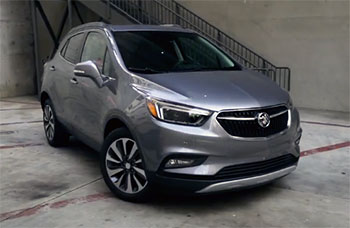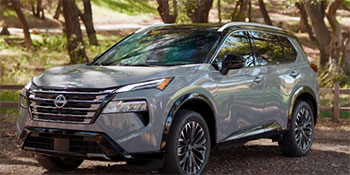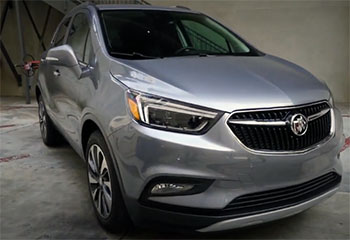I’ve been shopping for a compact SUV, and you know how overwhelming it can feel—endless options, specs, and features to compare. I narrowed it down to the 2022 Buick Encore and the 2024 Nissan Rogue, two popular choices for different reasons.
My goal here is to break down their pros and cons, share my experience, and help you decide which fits your life best. From city commutes to weekend getaways, I’ll compare performance, comfort, tech, and value to guide your choice.
Comparison Table: Buick Encore Vs. Nissan Rogue
| Feature | 2022 Buick Encore | 2024 Nissan Rogue |
|---|---|---|
| Starting MSRP | $26,100 | $28,420 |
| Engine | 1.4L Turbo 4-cylinder, 155 hp | 1.5L Turbo 3-cylinder, 201 hp |
| Fuel Economy (MPG) | 24 city / 32 highway (27 combined) | 30 city / 37 highway (33 combined) |
| Cargo Space | 18.8 ft³ (seats up), 48.4 ft³ (folded) | 31.6 ft³ (seats up), 74.1 ft³ (folded) |
| Interior Space | 40.8 in front legroom, 35.8 in rear | 43.3 in front legroom, 38.5 in rear |
| Safety Rating (NHTSA) | 5 stars | 4.3 stars |
| Infotainment | 8-inch touchscreen, Apple CarPlay | 8-inch touchscreen, Apple CarPlay |
| Warranty | 3 yr/36,000 mi (basic), 5 yr/60,000 mi (powertrain) | 3 yr/36,000 mi (basic), 5 yr/60,000 mi (powertrain) |
| Dimensions (LxWxH) | 171.4 x 70.1 x 65.3 in | 183.0 x 72.4 x 66.5 in |
My Journey with Compact SUVs
I’ve always loved the idea of a compact SUV—big enough for road trips, small enough to zip through city streets. The Buick Encore and Nissan Rogue caught my eye because they’re both practical but cater to slightly different vibes. The Encore feels like a cozy, upscale retreat, while the Rogue leans into family-friendly practicality. I test-drove both, pored over specs, and weighed what matters most to me: comfort, tech, efficiency, and cost. Let’s break it down so you can see which one aligns with your needs.
Performance: Power and Drive Feel
Buick Encore: Nimble but Underpowered

The 2022 Buick Encore comes with a 1.4-liter turbocharged four-cylinder engine pumping out 155 horsepower.
It’s paired with a six-speed automatic transmission, and I found it smooth for city driving.
Zipping through tight streets or parking in crowded lots felt effortless, thanks to the Encore’s compact size—171.4 inches long and a 100.6-inch wheelbase.
It’s agile, almost like driving a hatchback, which I appreciated during my urban test drive.
But here’s the catch: the Encore’s engine feels sluggish on highways. Merging onto freeways required more patience than I’d like, and accelerating to pass wasn’t exactly thrilling.
The all-wheel-drive (AWD) option helps with traction in slippery conditions, but it’s not standard, and I noticed a slight dip in fuel economy (23 city/30 highway) when equipped. If you’re mostly sticking to city commutes, the Encore’s nimble handling is a win, but long-distance drivers might crave more power.
Nissan Rogue: Punchy and Efficient

The 2024 Nissan Rogue, on the other hand, boasts a 1.5-liter turbocharged three-cylinder engine delivering 201 horsepower.
Paired with a continuously variable transmission (CVT), it feels peppier than the Encore. During my test drive, I noticed the Rogue’s confident acceleration, especially on highways.
It hit 60 mph faster than the Encore (about 7.8 seconds versus 9 seconds, per Motor Trend), making it a better pick for those who mix city and highway driving.
The Rogue’s ride is smooth, with a fully independent suspension that absorbs bumps better than the Encore’s semi-independent rear setup. Its longer wheelbase (106.5 inches) and wider track add stability, especially at higher speeds.
I also loved the fuel efficiency—30 city and 37 highway MPG, averaging 33 combined. That’s a noticeable edge over the Encore’s 27 combined MPG, saving you a few bucks at the pump over time.
Pros (Encore): Agile in tight spaces, smooth city ride, optional AWD.
Cons (Encore): Underpowered for highway driving, lower fuel economy.
Pros (Rogue): Stronger engine, better fuel economy, confident highway performance.
Cons (Rogue): CVT can feel less engaging, slightly larger footprint.
Also Read: Comparison of Buick Envision And Cadillac XT4.
Space and Comfort: Room to Stretch
Buick Encore: Cozy but Cramped
The Encore’s interior is where it tries to punch above its weight. I was impressed by the premium feel—soft-touch materials, a quiet cabin, and a well-designed dashboard. The seats are comfortable for short drives, and the second row offers 35.8 inches of legroom, which is decent for a subcompact SUV. However, taller passengers might feel squeezed, especially in the back, where headroom is tight at 38.0 inches.
Cargo space is a weak point. With 18.8 cubic feet behind the rear seats and 48.4 cubic feet with them folded, the Encore lags behind competitors. I could fit a few grocery bags or a small suitcase, but loading up for a weekend trip felt like a Tetris game. The Encore’s compact size makes it a champ for city parking, but you’ll sacrifice space for that maneuverability.
Nissan Rogue: Spacious and Family-Friendly
The Rogue, a compact SUV, feels like a different beast. Its interior is roomier, with 43.3 inches of front legroom and 38.5 inches in the rear—great for taller passengers or growing families. I stretched out comfortably in both rows, and the rear seats felt more accommodating for adults. Headroom is generous too, at 41.1 inches up front and 39.2 inches in the back.
Cargo capacity is a standout: 31.6 cubic feet with seats up and 74.1 cubic feet with them folded. I easily loaded camping gear and a cooler for a weekend trip, and there was still room to spare. The Rogue’s Divide-N-Hide storage system adds clever compartments for organizing smaller items, which I found super practical.
Pros (Encore): Premium interior, quiet cabin, easy to park.
Cons (Encore): Limited cargo space, cramped rear for taller passengers.
Pros (Rogue): Spacious interior, large cargo area, family-friendly.
Cons (Rogue): Less premium materials, slightly wider for tight parking.
Technology and Features: Staying Connected
Buick Encore: User-Friendly and Connected

The Encore’s tech suite is a highlight. Its standard 8-inch touchscreen is intuitive, with crisp graphics and quick responses.
Apple CarPlay and Android Auto come standard, so I could seamlessly connect my phone for navigation and music.
The MyBuick app impressed me with remote start, vehicle diagnostics, and a 4G Wi-Fi hotspot (standard on all trims). It’s perfect for staying connected on the go.
However, the Encore lacks some advanced driver-assist features unless you spring for higher trims.
Lane departure warning and rear cross-traffic alert aren’t standard, which felt like a miss for a vehicle aiming for a premium vibe. The base model’s tech is solid but not cutting-edge compared to rivals.
Nissan Rogue: Tech-Savvy and Safe
The Rogue steps up with a similar 8-inch touchscreen (upgradable to 9 inches on higher trims) and standard Apple CarPlay and Android Auto. I found Nissan’s interface slightly less polished than Buick’s but still user-friendly. The Rogue’s Nissan Intelligent Mobility suite includes standard features like rear cross-traffic alert and a driver attention monitor, which the Encore doesn’t offer at base levels.
Higher trims add a wireless charging pad and adaptive cruise control, which I loved for long drives. The Rogue’s ProPilot Assist (available on SL and Platinum trims) combines adaptive cruise with lane-keeping, making highway trips less tiring. Overall, the Rogue feels more tech-forward, especially for safety-conscious buyers.
Pros (Encore): Intuitive touchscreen, standard Wi-Fi hotspot, premium app integration.
Cons (Encore): Limited standard driver-assist features, pricey upgrades.
Pros (Rogue): Robust safety tech, available ProPilot Assist, practical features.
Cons (Rogue): Interface slightly less polished, some features trim-dependent.
Read More: My Thoughts On Acura MDX Vs. Volvo XC90
Safety: Peace of Mind on the Road
Buick Encore: Top Marks, Limited Features
The 2022 Buick Encore earns a stellar five-star NHTSA safety rating, which gave me confidence during my test drive. Standard features include a rearview camera, airbags, and stability control. However, advanced safety tech like automatic emergency braking or blind-spot monitoring requires upgrading to higher trims or option packages, which can bump up the price.
The Encore’s smaller size and nimble handling make it feel safe in urban settings, but I wished for more standard driver-assist features, especially given its premium positioning. Still, its solid crash test scores are a big plus.
Nissan Rogue: Strong but Not Perfect
The 2024 Nissan Rogue scores a 4.3-star NHTSA rating, slightly below the Encore but still respectable. It shines with standard safety features like rear cross-traffic alert, lane departure warning, and automatic emergency braking. The IIHS named the Rogue a Top Safety Pick for 2023, thanks to strong crash test performance and pedestrian detection.
I felt the Rogue’s safety suite was more comprehensive out of the gate, especially for families. Its longer wheelbase and wider track add stability, and the available 360-degree camera was a game-changer for parking. However, some users on forums like Reddit have raised concerns about Nissan’s CVT reliability, which could impact long-term peace of mind.
Pros (Encore): Five-star NHTSA rating, solid build quality.
Cons (Encore): Limited standard safety tech, costly upgrades.
Pros (Rogue): Comprehensive safety features, Top Safety Pick status.
Cons (Rogue): Slightly lower NHTSA rating, CVT reliability concerns.
Cost and Value: What’s Your Budget?
Buick Encore: Affordable Luxury
The Encore starts at $26,100, undercutting the Rogue by about $2,300. Its lower price and premium interior make it appealing for buyers seeking a luxury-like experience on a budget. I found the Encore’s base trim well-equipped, but adding AWD or advanced safety features pushes the price closer to $30,000. Depreciation is a concern—iSeeCars notes the Encore loses 44% of its value over five years, worse than the Rogue.
Maintenance costs are reasonable, and the Encore’s warranty (3 years/36,000 miles basic, 5 years/60,000 miles powertrain) is competitive. For city dwellers who value style over space, the Encore offers solid value.
Nissan Rogue: Practical Investment
The Rogue’s $28,420 starting MSRP reflects its larger size and better tech. It retains 42.6% of its value after five years, slightly better than the Encore, making it a smarter long-term investment. Fuel savings from its 33 MPG combined rating also add up. However, higher trims like the Platinum can exceed $35,000, which might stretch budgets.
Nissan’s warranty matches the Encore’s, but some owners report higher maintenance costs, especially for CVT-related issues. If you need space and tech, the Rogue justifies its price, but it’s less of a bargain upfront.
Pros (Encore): Lower starting price, premium feel, reasonable maintenance.
Cons (Encore): Steeper depreciation, pricey options.
Pros (Rogue): Better resale value, fuel efficiency, spaciousness.
Cons (Rogue): Higher starting price, potential CVT maintenance costs.
My Driving Experience: Real-World Impressions
Driving the Encore felt like slipping into a cozy, upscale bubble. Its quiet cabin and smooth ride made city commutes a breeze, but I noticed the lack of power on highways. Parking was a dream, and the tech kept me connected, but the small cargo area frustrated me when I tried to pack for a weekend trip.
The Rogue, by contrast, felt like a trusty road trip companion. Its roomy interior and strong acceleration made long drives enjoyable, and the cargo space handled all my gear. The safety tech gave me confidence, but I wasn’t thrilled with the CVT’s occasional lag. It’s better suited for families or those who prioritize space.
Which Should You Choose?
Your choice depends on your lifestyle. If you’re a city driver who values a premium feel and easy parking, the Encore is a great pick. Its lower price and upscale interior make it a budget-friendly luxury option, despite its smaller size and weaker engine. If you need space, power, and advanced safety tech, the Rogue is the better fit. Its versatility and efficiency suit families or frequent travelers, though it comes at a higher cost.
I leaned toward the Rogue for its practicality, but the Encore’s charm won me over for daily urban drives. Think about your priorities—space versus style, power versus price—and test-drive both to feel the difference.
Read More: My Thoughts On Acura MDX Vs. Lexus GX
Frequently Asked Questions (FAQ)
No, the Nissan Rogue is larger. The Rogue measures 183.0 inches long with a 106.5-inch wheelbase, while the Encore is 171.4 inches long with a 100.6-inch wheelbase. The Rogue also offers more cargo and passenger space.
It depends on your needs. The Buick Encore offers a premium interior and lower starting price, ideal for city driving. The Nissan Rogue provides more space, power, and safety tech, better for families or highway trips.
There’s no official confirmation from Nissan about discontinuing the Rogue as of July 2025. It remains a popular model, with the 2024 version receiving strong reviews.
The Encore has a solid reliability rating, with iSeeCars giving it 7.2 out of 10. Owners report fewer issues compared to some competitors, but long-term data is mixed.
Conclusion
Choosing between the Buick Encore and Nissan Rogue comes down to what you value most. I’ve laid out the pros and cons to help you make an informed decision. The Encore’s compact size and upscale vibe are perfect for city life, while the Rogue’s spaciousness and tech make it a family favorite. Test-drive both, consider your budget, and think about your daily drives. You’ll find the right SUV for your journey.

